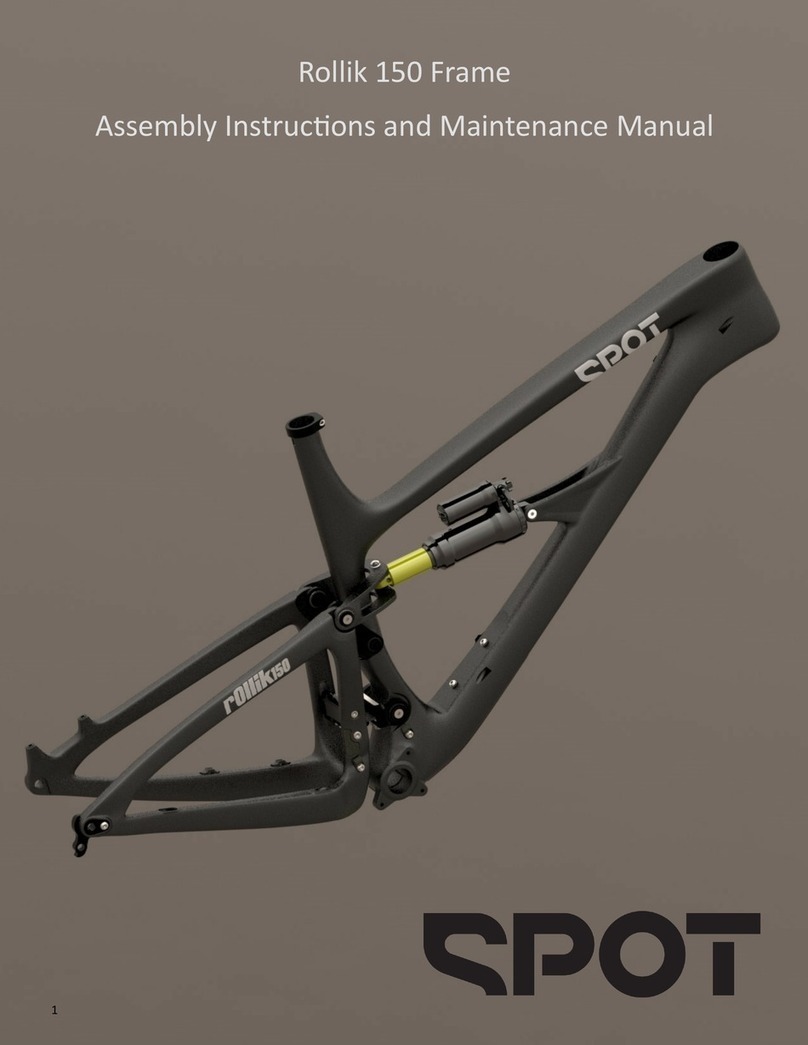5
Low Speed Compression Damping Adjuster
• Increases rmness and support on slow
compression (downward) stroke of the
fork. Firmer sengs will increase support
for bermed turns and “g-out” style slow
compressions.
• Approximately 16 clicks of adjustment
• Turn black dial clockwise to increase
rmness
• Soer: best for lighter riders, less
aggressive riding
• Firmer: best for heavier riders, more
aggressive riding
Air spring pressure
• Use included shock pump to increase/
decrease air pressure
• Sets sag / “ride height”
• Spot recommends starng by seng the fork
air spring pressure to 37% of your riding
weight (with helmet, pack, gear, etc.) in
pounds. For example, if you weigh 180lbs
ready to ride, you would inate your fork to
0.37 X 180 = 67psi.
• Increase pressure (up to +15psi) if you are
booming out frequently. If adding air
pressure does not prevent frequent boom
outs, you may need to upsize your VOLUME
SPACER.
• Decrease pressure (up to –10psi) if you are
never using full travel. If reducing air
pressure does not allow you to access full
travel you may need to downsize your
VOLUME SPACER.
Rebound Damping Adjusters- Under Black Cap
• Adjusts return speed “rebound” of suspension
• Turn clockwise to slow the rebound, counter-
clockwise to speed up.
• Adjustment sengs are referenced from “full
slow”. To adjust, turn the red rebound knob
clockwise unl it stops, then slowly unwind the
knob while counng each me it clicks.
• Spot recommended rebound sengs– based
on air spring pressure:
• Increase rebound speed if the bike feels rough
and low on fast secons with successive bumps
• Decrease rebound speed if the bike feels
“bucky”, like riding a pogo sck on successive
bumps.
Pressure (psi)
Low Speed
Rebound Seng
(clicks from full
slow)
High Speed
Rebound Seng
(clicks from full
slow)
40 98
40-50 87
50-60 76
60-70 65
70-80 54
80-90 43
90-100 32
100-110 21
110-120 10
Volume Spacers
• Air volume spacers are installed in the fork
to control how the spring forces increase
as the shock is compressed
• A larger volume spacer will make the fork
more progressive and harder to boom
out on big hits and landings
• A smaller volume spacer will make the fork
more linear and easier to access full travel.
• Changing volume spacers is a simple pro-
cess. Instrucons for swapping spacers can
be found here:
Fox Fork Volume Spacers
Travel Indicator O-Ring
• The fork seal will push the o-ring up the
stanchion tube as it compresses
• Measure from the seal to the o-ring to
determine your max travel usage.
• The Mayhem 130 comes stock with a
140mm travel fork.
High Speed Compression Damping Adjuster
• Increases rmness and support on fast
compression (downward) stroke of the
fork. Firmer sengs will increase support
for square edge hits and landing jumps
• Approximately 8 clicks of adjustment
• Turn blue dial clockwise to increase
rmness
• Soer: best for lighter riders, less
aggressive riding
• Firmer: best for heavier riders, more
aggressive riding
Fork Setup—Fox 36 GRIP2 Forks




























